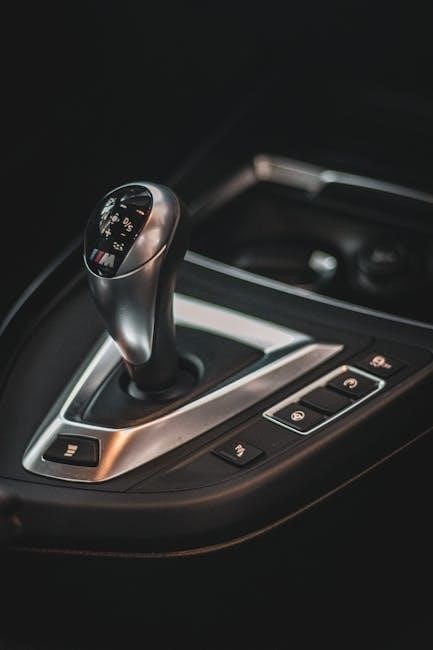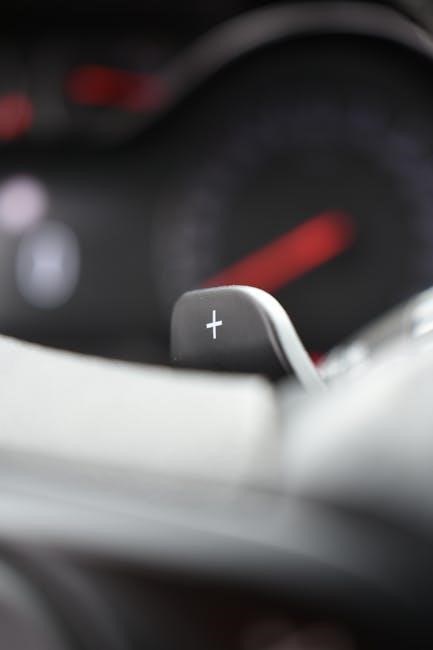Shift paddles and manual transmissions offer distinct driving experiences, catering to different preferences and needs. Paddle shifters provide quick, clutch-free gear changes, ideal for performance and convenience. Manual transmissions deliver tactile control and engagement, appealing to driving enthusiasts. Both systems have unique advantages, making the choice depend on driving style and priorities.
Overview of Shift Paddles
Shift paddles, located behind the steering wheel at the 3 and 9 o’clock positions, enable manual gear changes without a clutch pedal. They are typically found in automatic or dual-clutch transmissions, offering quick, seamless shifts. Paddle shifters are popular in performance cars, allowing drivers to maintain control while keeping hands on the wheel. They provide an ergonomic and intuitive way to shift gears, making them ideal for racing and dynamic driving scenarios where speed and responsiveness are crucial.
Overview of Manual Transmissions
Manual transmissions require a clutch pedal and gearshift to change gears, offering direct engine control and driver engagement. They are favored for their tactile feedback, fuel efficiency, and cost-effectiveness. With a manual, drivers must coordinate clutch presses and gear selections, providing a hands-on driving experience. This system is popular among enthusiasts who enjoy the connection to the vehicle and the skill involved in shifting, making it a preferred choice for those who value driving involvement and precision.
How Shift Paddles Work
Paddle shifters are electronic controls on the steering wheel that send signals to an automatic transmission, enabling manual gear changes without a clutch pedal or gearstick.
Design and Functionality of Paddle Shifters
Paddle shifters are electronic controls located on the steering wheel, typically behind the 3 and 9 o’clock positions. They allow drivers to manually shift gears in automatic or dual-clutch transmissions without using a clutch pedal. When activated, the paddles send electronic signals to the transmission, enabling instantaneous gear changes. This design enhances ergonomics and keeps hands on the wheel, improving control during spirited driving. The system is intuitive, with one paddle for upshifts and the other for downshifts, providing a seamless and engaging experience.
Comparison to Manual GearShift Mechanisms
Unlike manual transmissions, which require a clutch pedal and gearstick to operate, paddle shifters streamline the process by eliminating the clutch. This reduces driver effort and allows for quicker shifts. However, manuals offer a more tactile connection, with direct mechanical feedback. Paddle systems rely on electronic signals, potentially lacking the emotional engagement of a manual. Yet, they provide faster shift times and convenience, making them ideal for performance driving without the physical demands of a traditional manual setup.

Performance Comparison
Shift paddles deliver faster, more responsive gear changes, ideal for racing, while manual transmissions offer greater control and a direct driving experience, satisfying enthusiasts.
Shift Speed and Responsiveness
Shift paddles offer faster and more consistent gear changes due to electronic actuation, making them ideal for high-performance driving. Manual transmissions rely on driver skill, with slower shift times but a direct mechanical connection. Paddle shifters eliminate the need for a clutch, enabling rapid transitions without losing acceleration. In racing scenarios, paddle systems prove superior in speed and precision, while manuals depend on the driver’s ability to heel-toe and synchronize shifts effectively. This difference significantly impacts performance in competitive and dynamic driving environments.

Control and Precision in Driving
Manual transmissions provide direct mechanical control, allowing drivers to feel each gear change and connect with the vehicle. Paddle shifters, while precise, rely on electronic systems, reducing tactile feedback. Manuals enable techniques like heel-toe shifting, enhancing control during cornering. Paddles, however, keep hands on the wheel, improving stability. Both systems offer unique precision, but manuals excel in driver engagement, while paddles prioritize convenience and speed, catering to different driving styles and preferences for control and connection to the car.
Usability and Driver Experience
Shift paddles offer effortless gear changes without a clutch, enhancing convenience. Manuals provide tactile engagement but require more skill. Both cater to different driver preferences and ease of use.
Ease of Use and Accessibility
Shift paddles are more accessible, requiring no clutch pedal, making them easier to use in stop-and-go traffic. Manuals demand more skill and physical effort, limiting accessibility for some drivers.
Learning Curve for New Drivers
Paddle shifters have a gentler learning curve, as they eliminate the need for clutch coordination, making them more forgiving for new drivers. Manual transmissions require mastering the clutch-pedal balance, which can be challenging and time-consuming. Paddle systems allow drivers to focus on steering and acceleration without the complexity of manual gear coordination, reducing the barrier to entry for novice drivers seeking to gain control over gear shifts.
Key Features and Benefits
Paddle shifters offer ease of use, quick gear changes, and convenience, ideal for performance and daily driving. Manual transmissions provide direct control, driver engagement, and a tactile experience, appealing to enthusiasts seeking a more connected driving experience.
Advantages of Paddle Shifters
Paddle shifters offer faster and more precise gear changes compared to traditional manual transmissions, enhancing performance and responsiveness. They eliminate the need for a clutch pedal, reducing driver fatigue and allowing seamless control. Ideal for racing and performance driving, paddle shifters enable quick upshifts and downshifts without taking hands off the wheel. Their ergonomic design and intuitive operation make them user-friendly, while advanced technology ensures smooth and efficient gear transitions, catering to both casual and enthusiast drivers.
Advantages of Manual Transmissions
Manual transmissions provide a direct, tactile connection between the driver and the vehicle, offering precise control over gear shifts. They often deliver better fuel efficiency and lower costs compared to automatics. Manual transmissions also encourage active driving engagement, which many enthusiasts find rewarding. Additionally, they typically require less complex technology, reducing maintenance needs. For drivers who enjoy the hands-on experience, manuals offer a satisfying driving experience that fosters a deeper connection to the road.

Real-World Applications
Shift paddles excel in racing, enabling rapid gear changes without losing grip. Manuals thrive in daily driving, offering better fuel efficiency and lower maintenance costs.
Shift Paddles in Racing and Performance Cars
Shift paddles dominate in racing and high-performance vehicles due to their lightning-fast gear changes. They allow drivers to maintain grip and focus on steering, enhancing lap times. Modern systems, like dual-clutch transmissions, enable seamless shifts without lost power. This technology is favored by professional drivers for its precision and speed, making it a cornerstone in competitive motorsports. Their ergonomic design ensures drivers can control gears intuitively, optimizing performance in demanding conditions.

Manual Transmissions in Daily Driving
Manual transmissions remain popular for daily driving due to their cost-effectiveness and fuel efficiency. They offer direct control and a connected driving experience, appealing to enthusiasts. Clutch operation can be less convenient in traffic, but many drivers appreciate the engagement. Manuals are often lighter and simpler, reducing maintenance costs. While not as fast as paddle shifters in performance scenarios, they provide a satisfying, hands-on experience for everyday commuting and driving enjoyment.
Personal Preference and Driving Style
Driver preferences often dictate the choice between shift paddles and manuals. Some value the convenience and speed of paddles, while others enjoy the tactile engagement of manuals.
Driver Preferences and Satisfaction
Drivers often choose between shift paddles and manual transmissions based on personal satisfaction. Paddle shifters appeal to those seeking convenience and speed, offering seamless gear changes without a clutch. Manuals, however, provide a tactile connection, enhancing the driving experience for enthusiasts. Satisfaction varies widely, as some prefer the ease of paddles, while others find joy in the mechanical engagement of a manual. This divide highlights how individual preferences shape transmission choices, with no universal “best” option.
Impact of Driving Style on Transmission Choice
Driving style significantly influences the choice between shift paddles and manual transmissions. Aggressive drivers often favor paddles for rapid shifts, enhancing performance in high-speed scenarios. Conversely, those who prioritize control and connection opt for manuals, enjoying the tactile feedback. Daily commuters might lean toward paddles for convenience, while enthusiasts prefer manuals for the engaging experience. Ultimately, driving habits and preferences dictate transmission selection, reflecting individual needs for performance, ease, or driving involvement.
Cost and Maintenance
Paddle shift systems are typically more expensive than manuals due to advanced technology. Manuals often require less maintenance, with fewer components, making them more cost-effective long-term.
Cost Differences Between Systems
Paddle-shift systems are generally more expensive due to their advanced technology and components like electronic controls and sensors. Manual transmissions, with fewer parts, are often more cost-effective. Maintenance for manuals is typically simpler and cheaper, involving clutch replacements and gear oil changes. Paddle systems, while requiring less frequent maintenance, may incur higher costs when repairs are needed due to their complex components. Overall, manuals are more budget-friendly, while paddle systems come with a higher initial investment.
Maintenance Requirements
Manual transmissions typically require more frequent maintenance, including clutch replacements and gear oil changes. Paddle-shift systems, with fewer mechanical parts, need less routine maintenance but may require electronic component checks. Manuals are simpler in design, making repairs more straightforward, while paddle systems involve complex electronics, potentially leading to higher repair costs when issues arise. Overall, manual transmissions are more maintenance-intensive but easier to service, whereas paddle systems offer lower upkeep but may be costlier to fix.
Future Trends and Innovations
Shift paddles may evolve with advanced automation, while manuals could integrate hybrid systems. Paddle technology might focus on faster, seamless shifting, enhancing performance driving experiences further.
Evolution of Paddle Shift Technology
Paddle shift technology has advanced significantly, offering faster and more seamless gear changes. Modern systems integrate with advanced transmissions like DSG and CVT, enhancing performance and responsiveness. Recent innovations include haptic feedback and AI-driven predictive shifting, improving driver engagement and efficiency. Paddle shifters now cater to both performance enthusiasts and everyday drivers, blending convenience with control. This evolution highlights a shift toward more intuitive and adaptive driving experiences, making paddle shift systems increasingly popular across various vehicle types.
Modern Manual Transmission Developments
Manual transmissions have seen advancements to enhance performance and usability. Modern manuals feature improved synchronizers, reduced gear noise, and shorter shift throws for smoother operation. Some now include automated rev-matching and downshift rev-blipping, aiding in driver control and reducing wear. Hybrid manual gearboxes are emerging, combining traditional driver engagement with electric assistance for better fuel efficiency. These developments ensure manuals remain relevant, blending tradition with innovation to meet contemporary driving demands and preferences.
Shift paddles offer speed and convenience, while manual transmissions provide tactile engagement. The choice depends on personal preference, driving style, and specific needs, making both systems viable options.
Final Thoughts on Shift Paddles vs Manual
Shift paddles and manual transmissions each excel in specific scenarios. Paddle shifters shine in performance driving with their rapid, clutch-free shifts, enhancing speed and control. Manuals, however, offer a unique tactile experience, fostering a deeper connection with the vehicle. Driver preference, lifestyle, and priorities ultimately dictate the choice. Both systems cater to distinct needs, ensuring a tailored driving experience for enthusiasts and everyday drivers alike.
